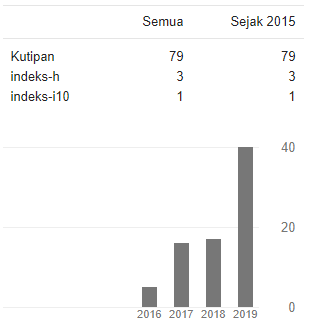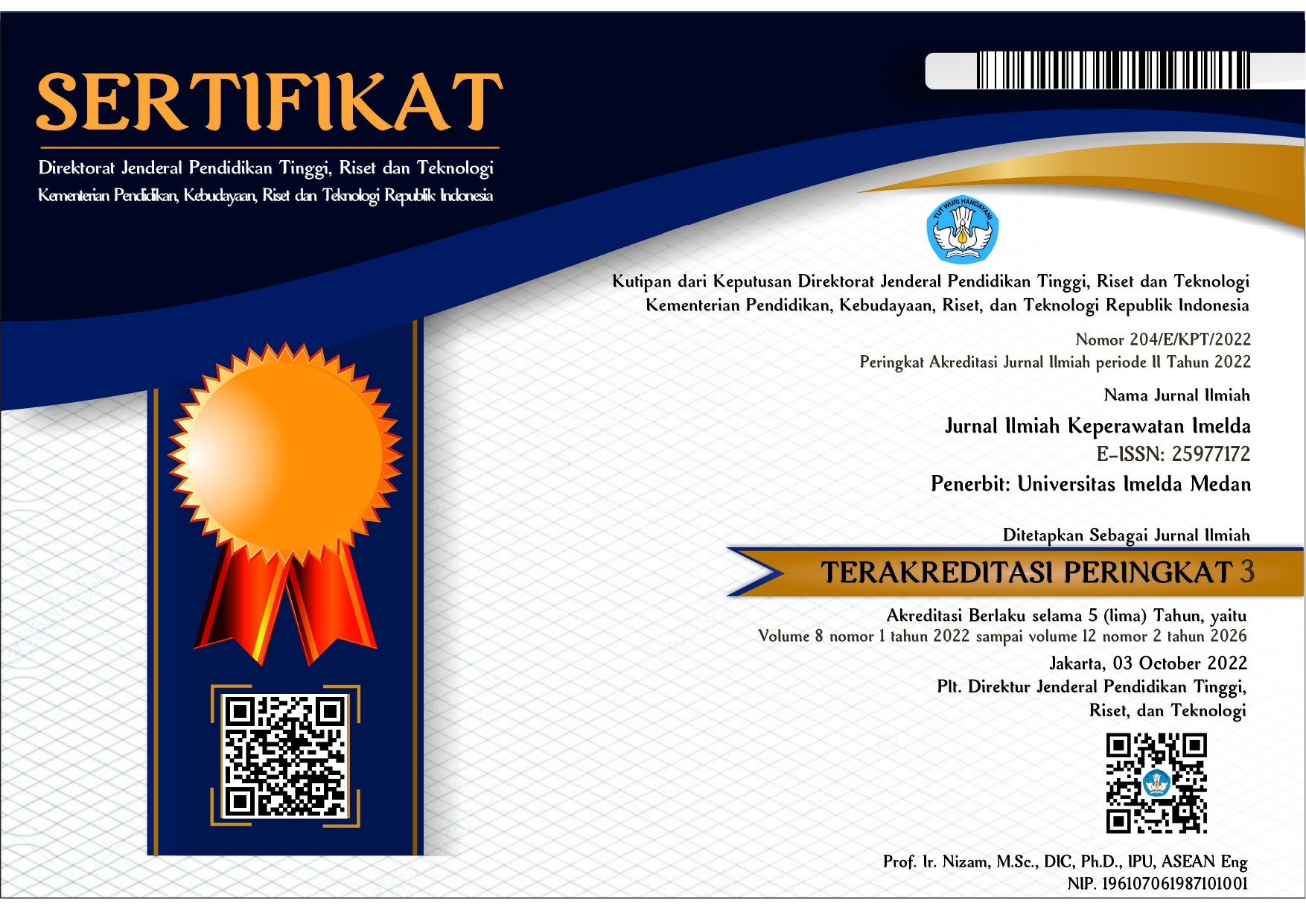SURVEI PERILAKU PENCEGAHAN COVID-19 PADA IBU MAHASISWA NERS STIKes SANTA ELISABETH MEDAN
DOI:
https://doi.org/10.52943/jikeperawatan.v7i2.589Keywords:
Chainsaw, Covid-19 PreventionAbstract
COVID-19 is categorized as an infectious disease. The increase in the number of COVID-19 cases took place quite quickly and spread outside the Wuhan area and other countries. break the chain of transmission of COVID-19 by calling for the Independent Health Care Family Movement (GERGAJI). The research design used is descriptive with the Cross Sectional method. The population in this study were all students of the Nursing Study Program level II STIKes Santa Elisabeth Medan. Sampling in the study using the Total Sampling technique with a total sample of 84 respondents. The researcher collected data using a google form in the form of a questionnaire consisting of 16 statements regarding the application of the Covid-19 prevention saw method. The results showed that most of the respondents' behavior always used a mask when leaving the house, as much as 72.6%. Most of the respondents' behavior is always washing hands with soap, as much as 47.6%. Most of the respondents' behavior always kept their distance, as much as 52.4%. Most of the respondents' behavior always uses hand sanitizer, as much as 51.2%. Most of the respondents' behavior is always cleaning the house, as much as 82.1%. Most of the respondents' behavior is always doing activities at home, as much as 32.1%. Health workers need to increase public awareness through communication and education in preventing Covid-19 so that people are able to prevent Covid-19.
Downloads
References
Fan,Y., Zhao, K., Shi, Z. L., & Zhou, P. 2019. Bat Coronaviruses in China. Viruses, 11(3), 210.
Guan, Wei-jie, Zheng-yi Ni, Yu Hu, Wen-hua Liang, Chun-quan Ou, Jian-xing He, Lei Liu et al. "Clinical characteristics of coronavirus disease 2019 in China." New England Journal of Medicine (2020).
Herdiana, D. (2020). Penanggulangan COVID-19 Tingkat Lokal Melalui Kebijakan Adaptasi Kebiasaan Baru (AKB) di Provinsi Jawa Barat. Journal of Governance Innovation. https://doi.org/10.36636/jogiv.v2i2.442.
Huang, W. H., Teng, L. C., Yeh, T. K., Chen, Y. J., Lo, W. J., Wu, M. J., ... & Lin, C. F. (2020). 2019 novel coronavirus disease (COVID-19) in Taiwan: Reports of two cases from Wuhan, China. Journal of Microbiology, Immunology and Infection.
Kakodkar, P., Kaka, N., & Baig, M. N. 2020. A Comprehensive Literature Review on the Clinical Presentation, and Management of the Pandemic Coronavirus Disease 2019 (COVID-19). Cureus, 12(4).
KEBUMENKAB. 2020. BNPB Serukan GERGAJI HABIS COVID-19
Sumber : https://www.kebumenkab.go.id/index.php/public/news/detail/5406. diakses pada tangga 26 April 2020.
Kementerian Kesehatan Republik Indonesia. 2016. Pedoman umum program Indonesia Sehat dengan pendekatan keluarga. Jakarta: Kementerian Kesehatan RI.
Kimball, A. et al. (2020) ‘Asymptomatic and Presymptomatic SARS-CoV-2 Infections in Residents of a Long-Term Care Skilled Nursing Facility — King County, Washington, March 2020’, MMWR. Morbidity and Mortality Weekly Report. doi: 10.15585/mmwr.mm6913e1.
Low, D. E. (2020). Guidline for the Use of non-pharmaceutica measures to delay and mitigate the impact of 2019-Ncov. Diakses pada tanggal 25 April 2020.
Muhammad Tauiq, M. N. & S. R. (2013). Gambaran Prilaku Hidup Bersih dan Sehat (PHBS) Masyarakat Di Kelurahan Parangloe Kecamatan Tamalanrea Kota Makassar. 1–12. Retrieved from repository.unhas.ac.id.
Natalia, R. N., Malinti, E., & Elon, Y. (2020). Kesiapsiagaan Remaja Dalam Menghadapi Wabah Covid-19. Jurnal Ilmiah Kesehatan Diagnosis, 15(2020).
Nurhalimah, N. 2020. UPAYA BELA NEGARA MELALUI SOSIAL DISTANCING DAN LOCKDOWN UNTUK MENGATASI WABAH COVID-19 (Efforts to Defend the Country Through Social Distancing and Lockdown to Overcome the COVID-19 plague). Available at SSRN 3576405.
Nurjanah, Mitha. 2019. Teori Keluarga: Studi Literatur. https://www.researchgate.net/publication/334454369_TEORI_KELUARGA. Diakses pada tanggal 26 April 2020.
PERSI. 2020. Pedoman Umum Menghadapi PANDEMI COVID-19 bagi Pemerintah Daerah; Pencegahan, Pengendalian, Diagnosis dan Manajemen.
https://www.persi.or.id/images/2020/data/pedoman_kesiapsiagaan_covid19.pdf. diakses pada tanggal 26 April 2020.
Polit, D. F., & Beck. 2012. Nursing Research: Generating and Assesing Evidence for Nursing Practice (9th ed). Philadelphia: Lippincott.
Razi F., Yulianty V., Amani, S A., Fauzia J H. (2020). Bunga Rampai COVID-19: Buku Kesehatan Mandiri untuk Sahabat. PD Prokami: Depok.
Singhal, T. 2020. A review of coronavirus disease-2019 (COVID-19). The Indian Journal of Pediatrics, 1-6.
Werdhani, R.A., Setiawati, E.P. and Rinawan, F.R., 2017. Peran Keluarga dalam Pengelolaan Kasus di Layanan Primer Melalui Five Family Oriented Questions. eJournal Kedokteran Indonesia, 5(1), pp.18-26.
World Health Organization. “Report of the WHO-China Joint Mission on Coronavirus Disease 2019 (COVID-19)” (PDF): 11–12. Retrieved 5 March 2020
Zhu, N., Zhang, D., Wang, W., Li, X., Yang, B., Song, J., ... & Niu, P. 2020. A novel coronavirus from patients with pneumonia in China, 2019. New England Journal of Medicine.









